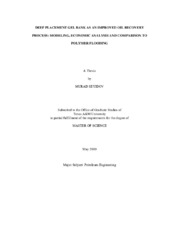| dc.description.abstract | Many attempts have been made to control water conformance. It is very costly to
produce, treat and dispose of water, and produced water represents the largest waste
stream associated with oil and gas production. The production of large amounts of water
results in: (a) the need for more complex water?oil separation; (b) corrosion of wellbore
and other equipment; (c) a rapid decline in hydrocarbon production rate and ultimate
recovery; and (d) consequently, premature abandonment of a well or field, leaving
considerable hydrocarbons unproduced.
Sometimes water production results from heterogeneities in the horizontal
direction, which leads to uneven movement of the flood front and subsequent early
breakthrough of water from high permeability layers. This problem is exacerbated if
there is (vertical) hydraulic communication between layers so that crossflow can occur.
One of the novel technologies in chemical enhanced oil recovery (EOR) is a gel
type called deep diverting gel (DDG), which describes material that functions by
plugging thief zones deep from the well where they were being injected. To evaluate the performance of this new treatment method, we will (1) model the treatment methods, (2)
conduct economic analysis, and (3) compare different EOR methods.
We have conducted relevant literature review about the development, design,
modeling and economics of the enhanced oil recovery methods. Schlumberger's Eclipse
simulator software has been used for modeling purposes.
Modeling runs have demonstrated that placement of a DDG in a high
permeability zone provided a blockage that diverted water into lower permeability areas,
thus increasing the sweep of target zones. Research results demonstrated that, although
higher recovery can be achieved with a polymer flood, the combination of delayed
production response and large polymer amounts cause such projects to be less
economically favorable than deep gel placement treatments. From results of several
sensitivity runs, it can be concluded that plug size and oil viscosity are two determining
factors in the efficiency of DDG treatments.
For the assumed case, economic analysis demonstrated that DDG has the most
positive net present value (NPV), with polymer flooding second and simply continuing
the waterflood to its economic limit the least positive NPV. | en |


